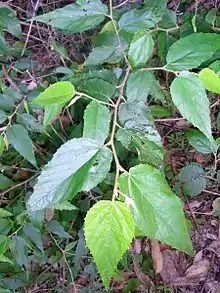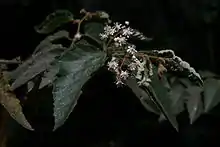Androcalva fraseri
Androcalva fraseri, commonly known as blackfellow's hemp or brush kurrajong is a common shrub or small tree of the mallow family found in eastern Australia.[2] Growing up to 8 metres tall, it is found in rainforest margins and in wet eucalyptus forests.
| Brush kurrajong | |
|---|---|
 | |
| Androcalva fraseri, Telegherry River, near Dungog, Australia | |
| Scientific classification | |
| Kingdom: | Plantae |
| Clade: | Tracheophytes |
| Clade: | Angiosperms |
| Clade: | Eudicots |
| Clade: | Rosids |
| Order: | Malvales |
| Family: | Malvaceae |
| Genus: | Androcalva |
| Species: | A. fraseri |
| Binomial name | |
| Androcalva fraseri | |
| Synonyms[1] | |
| |
Description
Androcalva fraseri is a shrub that typically grows to a height of 2 or 3 m (6.6 or 9.8 ft) shrub,[3] or a small tree to 8 m (26 ft) high. Arranged alternately along the stems,[4] the ovate leaves have irregularly toothed margins and are 5–17 cm (2.0–6.7 in) long and 2–7 cm (0.79–2.76 in) wide. The leaf undersides are whitish, and covered in a fine fur.[2] Flowering peaks in September and continues till November.[5] The small white flowers are arranged in clusters. Flowering is followed by the development of fruit, 1.5 to 2.5 cm (0.59 to 0.98 in) long.[3]
Taxonomy
The French naturalist Jacques Etienne Gay was the first to formally describe the species in 1823. He gave it the name Commersonia fraseri and published the description in the journal, Mémoires du Muséum d'Histoire Naturelle.[6][7]
A 2011 molecular analysis of segments of chloroplast DNA found that the genera Commersonia and Rulingia formed a monophyletic group but that the member species were intermingled, and split out into two hitherto unrecognised clades.[8] In 2011, Carolyn Wilkins and Barbara Whitlock changed the name to Androcalva fraseri.[9][10]
The specific epithet honours Charles Fraser, an early New South Wales colonial botanist.[4] Vernacular names include brush kurrajong and blackfellows hemp.
Distribution and habitat

Androcalva fraseri is found in rainforest and wet eucalypt forest along and east of the Great Dividing Range in New South Wales[2] and southeastern Queensland.[4] In the latter habitat, it is associated with trees such as rough-barked apple (Angophora floribunda), turpentine (Syncarpia glomulifera), and Sydney blue gum (Eucalyptus saligna).[5] A fast-growing plant, it is able to colonise disturbed ground,[5] particularly areas where vegetation has been partly cleared such as under power lines.[3]
It is an adult host plant for the chrysomelid beetle Podagra submetallica.[11]
Use in horticulture
Androcalva fraseri has been propagated readily from cuttings taken in winter, and grows better with extra moisture in cultivation.[4]
References
- "Androcalva fraseri". Australian Plant Census. Retrieved 22 February 2020.
- "Commersonia fraseri". PlantNET – NSW Flora Online. Retrieved 2010-11-16.
- Fairley, Alan; Moore, Philip (2000). Native Plants of the Sydney District:An Identification Guide (2nd ed.). Kenthurst, New South Wales: Kangaroo Press. p. 80. ISBN 0-7318-1031-7.
- Lodder, Mark (16 December 2003). "Growing Native Plants: Commersonia fraseri". Canberra, Australian Capital Territory: Australian National Botanic Gardens, Australian Government. Retrieved 8 December 2011.
- Benson, Doug; McDougall, Lyn (2001). "Ecology of Sydney plant species Part 8: Dicotyledon families Rutaceaae to Zygophyllaceae" (PDF). Cunninghamia. 7 (2): 241–462. Archived from the original (PDF) on 2009-06-14. Retrieved 2011-12-08.
- "Commersonia fraseri". APNI. Retrieved 22 February 2020.
- Gay, Jacques E. (1823). "Fragment d'une monographie des vraies Buttneriacées". Mémoires du Muséum d'Histoire Naturelle. 10: 215–216. Retrieved 22 February 2020.
- Whitlock, Barbara A.; Hale, Amanda M.; Indorf, Jane L.; Wilkins, Carolyn F. (2011). "Polyphyly of Rulingia and Commersonia (Lasiopetaleae, Malvaceae s.l.)". Australian Systematic Botany. 24 (5): 215–25. doi:10.1071/SB09030.
- "Androcalva fraseri". APNI. Retrieved 22 February 2020.
- Wilkins, Carolyn F.; Whitlock, Barbara A. (2011). "A new Australian genus, Androcalva, separated from Commersonia (Malvaceae s.l. or Byttneriaceae)". Australian Systematic Botany. 24 (5): 284–349. doi:10.1071/SB10032.
- Hawkeswood, Trevor J. (2005). "Three new host plants for the Australian leaf beetle Podagrica submetallica (Blackburn, 1894) (Coleoptera: Chrysomelidae: Alticinae)" (PDF). Calodema. 4: 19–22. Archived from the original (PDF) on 2012-04-23. Retrieved 2011-12-08.
External links
 Media related to Androcalva fraseri at Wikimedia Commons
Media related to Androcalva fraseri at Wikimedia Commons